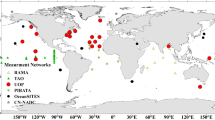Abstract
Ocean microwave emissions changed by the ocean wind at 6 GHz were investigated by combining data of the Advanced Microwave Scanning Radiometer (AMSR) and SeaWinds, both aboard the Advanced Earth Observation Satellite-II (ADEOS-II). This study was undertaken to improve the accuracy of the sea surface temperature (SST) retrieved from the AMSR 6 GHz data. Two quantities, 6V*(H*), were defined by the brightness temperature of the AMSR at 6 GHz with two polarizations (V-pol and H-pol), adjusted for atmospheric effects and with a calm ocean surface emission removed. These quantities represent a microwave emission change due to the ocean wind at 6 GHz. 6V* does not change in a region where 6H* is less than around 4 K (referred to as z0). Both 6V* and 6H* increase above z0. The 6V* to 6H* ratio, sp, varies with the relative wind directions. Furthermore, the sp values vary with the SST, between the northern and southern hemisphere, and seasonally. By specifying appropriate values for z0 and sp, the SST error between AMSR and buoy measurement became flat against 6H*, which is related to the ocean wind. Two extreme cases were observed: the Arabian Sea in summer and the Northwestern Atlantic Ocean in winter. The air-sea temperature difference in the former case was largely positive, while it was largely negative in the latter. The 6V* and 6H* relations differed from global conditions in both cases, which resulted in incorrect SSTs in both areas when global coefficients were applied.
Similar content being viewed by others
References
Hollinger, J. P. and R. C. Lo (1984): Determination of sea surface temperature with N-ROSS. Naval Research Laboratory Memorandum Report 5375.
Kawanishi, T. et al. (2003): The Advanced Microwave Scanning Radiometer for the Earth Observing System (AMSRE), NASDA’s contribution to the EOS for Global Energy and Water Cycle Studies. IEEE Trans. Geosci. Remote Sensing, 41, 184–194.
Klein, L. A. and C. T. Swift (1977): An improved model for the dielectric constant of sea water at microwave frequencies. IEEE Trans. Antennas and Propagation, 25, 104–111.
Liu, W. T. (2002): Progress in scatterometer application. J. Oceanogr., 58, 121–136.
Reynolds, R. W. and T. M. Smith (1994): Improved global sea surface temperature analyses. J. Climate, 7, 929–948.
Shibata, A. (2003): A change of microwave radiation from the ocean surface induced by air-sea temperature difference. Radio Science, 38(4), 8063–8072.
Shibata, A. (2004): AMSR/AMSR-E SST algorithm developments: removal of ocean wind effect. Italian J. Remote Sensing, 30/31, 131–142.
Wentz, F. J. (1992): Measurements of oceanic wind vector using satellite microwave radiometers. IEEE Trans. Geosci. Remote Sensing, 30, 960–972.
Author information
Authors and Affiliations
Corresponding author
Rights and permissions
About this article
Cite this article
Shibata, A. Features of ocean microwave emission changed by wind at 6 GHz. J Oceanogr 62, 321–330 (2006). https://doi.org/10.1007/s10872-006-0057-3
Received:
Revised:
Accepted:
Issue Date:
DOI: https://doi.org/10.1007/s10872-006-0057-3




